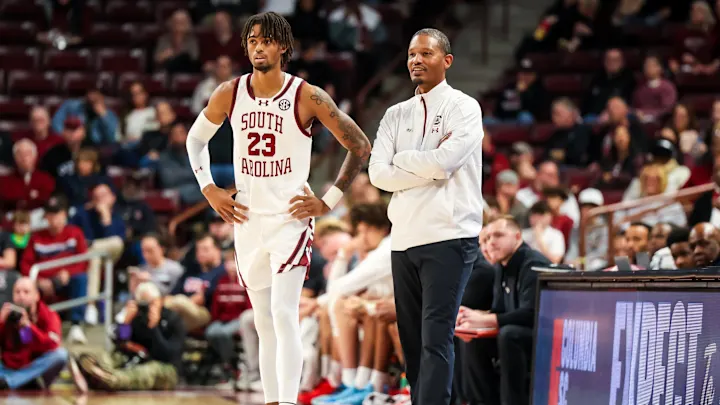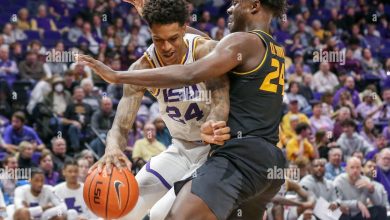Gamecocks Freshman Cam Scott to Enter the Transfer Portal

Gamecocks Freshman Cam Scott to Enter the Transfer Portal: A Turning Point for South Carolina Basketball
In a surprising move that has sent shockwaves through the South Carolina Gamecocks basketball program, freshman guard Cam Scott has announced that he will enter the transfer portal. Scott, who was highly anticipated to make an immediate impact during his first year at South Carolina, made his decision known through social media, leaving fans, teammates, and coaches to digest the news and consider what this departure means for the program.
The news of Cam Scott’s decision comes as a significant turn of events for South Carolina basketball, a program that has been working hard to rebuild and regain its former glory. For many, Scott represented the hope of the future—a top recruit with potential to contribute to the Gamecocks’ resurgence in the competitive Southeastern Conference (SEC). His exit from the program raises questions not only about the reasons behind his decision but also about the future of South Carolina basketball under head coach Lamont Paris.
In this article, we will take a closer look at Cam Scott’s background, why his departure is noteworthy, the potential reasons for his decision to transfer, and what this move means for the South Carolina Gamecocks going forward. We will also explore how this shift impacts the broader college basketball landscape, especially in an era dominated by the transfer portal.
Cam Scott’s Recruitment and Expectations at South Carolina
Cam Scott came to South Carolina with significant fanfare. A highly rated recruit out of high school, Scott was regarded as one of the top players in his class and a key component of the Gamecocks’ future. His skill set was highly sought after by college programs across the country, and his decision to commit to South Carolina was seen as a major victory for head coach Lamont Paris, who was in the midst of trying to build a competitive program in the SEC.
Scott, a guard with a versatile scoring ability and strong defensive skills, was expected to make an immediate impact for the Gamecocks. His high school performance showed promise in multiple areas—shooting, ball-handling, and athleticism—that made him an intriguing prospect for South Carolina’s backcourt. Expectations were high, and fans were eager to see what he could bring to a team that had struggled to regain its footing in the SEC in recent years.
In particular, Scott’s decision to come to South Carolina was seen as a crucial step for Paris in creating a more competitive roster. Paris, who had taken over as head coach in 2022, was in the midst of reshaping the program, focusing on player development, rebuilding the team’s identity, and building relationships with recruits. The arrival of Scott, alongside other young players, represented the future of the program and a hopeful vision for what South Carolina basketball could become.
Unfortunately, Scott’s freshman season did not unfold as expected. Despite his potential, his playing time was limited early in the season, and he faced competition from other talented guards on the roster. While it’s not unusual for a freshman to experience growing pains, it was clear that Scott was struggling to find consistent minutes and rhythm within the team’s system. His decision to transfer was likely influenced by a variety of factors, not just his performance on the court.
The Transfer Portal Era: A New Reality for College Basketball
The transfer portal has completely altered the landscape of college basketball. No longer are players locked into a single program for their entire careers, as the portal provides an opportunity for athletes to explore new environments and opportunities. For Scott, this is a pivotal moment in his career. With the rise of the portal, players now have more freedom than ever to switch schools, often seeking better playing time, a more favorable system, or a chance to play for a different coach.
Scott’s move to the transfer portal is a reflection of the broader trends in college basketball. In recent years, the NCAA’s introduction of the transfer portal and the one-time transfer rule, which allows players to transfer without sitting out a season, has reshaped how programs build their rosters. For Scott, it’s clear that he’s taking advantage of the opportunity to find a better fit, both for his playing style and his career aspirations.
The transfer portal has given rise to a new dynamic in college basketball recruitment, where programs must constantly recruit their own players to prevent them from transferring out. It also makes team-building more fluid, as coaches must be prepared to continually adapt to the changing landscape. South Carolina, like many other programs, will now have to re-evaluate its strategy in light of Scott’s decision to leave.
What Led to Cam Scott’s Decision to Transfer?
While the exact reasons behind Scott’s decision to enter the transfer portal have not been fully disclosed, there are several potential factors that could have contributed to his departure from South Carolina.
- Playing Time and Role on the Team: One of the most common reasons players enter the transfer portal is a lack of playing time or dissatisfaction with their role on the team. Scott, despite his potential, faced stiff competition for minutes in the backcourt. South Carolina had several guards on its roster, and Scott’s role was not as prominent as many had anticipated. For a player with high aspirations and a desire to develop, a lack of consistent playing time can be a major factor in the decision to transfer.
Scott likely recognized that his growth as a player could be better facilitated in a program where he had a more significant role. A transfer would allow him the opportunity to find a situation where he could be a more integral part of the offense and play more regularly, which is important for his development both as a player and in terms of his future prospects.
- Coaching and System Fit: College basketball programs run a variety of offensive and defensive systems, and not all systems are conducive to every player’s strengths. It’s possible that Scott found the coaching style or the system at South Carolina to be a poor fit for his skill set. The relationship between a player and coach is crucial, and a mismatch in playing style or a lack of connection with the coaching staff can lead to a decision to transfer.
In Scott’s case, he may have realized that his skill set could be better utilized in a different system or with a coach whose vision for him was more aligned with his goals. While head coach Lamont Paris is known for his emphasis on defense and player development, it’s possible that Scott was seeking a more fast-paced or offensive-minded system, or simply a coaching staff that could bring out the best in him.
- The Pressure of Expectations: With a high level of expectation comes significant pressure. As a highly ranked recruit, Scott may have felt the weight of the expectations placed on him. While he undoubtedly has the talent to succeed, adjusting to the rigors of college basketball can be a daunting challenge. Freshmen often have to deal with the pressure of proving themselves, which can sometimes lead to frustration and the desire to seek a fresh start elsewhere.
- Team Dynamics and Culture: Team chemistry and locker room dynamics play a crucial role in a player’s experience at college. While the decision to transfer is often viewed through the lens of individual performance and development, it is equally important to consider the atmosphere within the team. It’s possible that Scott’s decision to leave was influenced by factors outside of basketball, such as a lack of connection with teammates or challenges adjusting to the culture of the program.
The Impact on South Carolina Basketball
Cam Scott’s departure is undoubtedly a setback for the South Carolina Gamecocks. As a promising young player, Scott was expected to be a building block for the future of the program. His transfer means that the Gamecocks will lose out on a talent that could have played a pivotal role in their backcourt for years to come. South Carolina will now need to look elsewhere to replace the production and potential that Scott brought to the table.
From a broader perspective, this situation highlights the challenges faced by programs like South Carolina, which are in the midst of rebuilding. While the transfer portal can bring in new talent, it can also lead to the departure of key players. In a program that is striving to become more competitive in the SEC, losing a highly touted freshman can disrupt the development process and create uncertainty for the coaching staff.
Coach Lamont Paris will now have to reassess his strategy for the future. The Gamecocks will need to recruit players who can step in and contribute immediately, and Paris will have to navigate the transfer portal to fill the void left by Scott. While South Carolina still has plenty of young talent and a committed coaching staff, Scott’s departure underscores the instability and unpredictability that the transfer portal introduces to the game.
Looking Ahead: What’s Next for Cam Scott?
For Cam Scott, the decision to enter the transfer portal represents a new chapter in his college basketball journey. As one of the top recruits in his class, he will likely have no shortage of suitors. Programs across the country will be eager to add him to their roster, as he brings a combination of athleticism, scoring ability, and upside that is hard to ignore.
Scott will now have the opportunity to choose a program that better suits his style of play and offers the kind of environment where he can develop to his full potential. His decision to transfer could very well lead to a breakout year at his next destination, and it’s entirely possible that he will thrive in a new setting, where he can be more of a focal point for his team.









